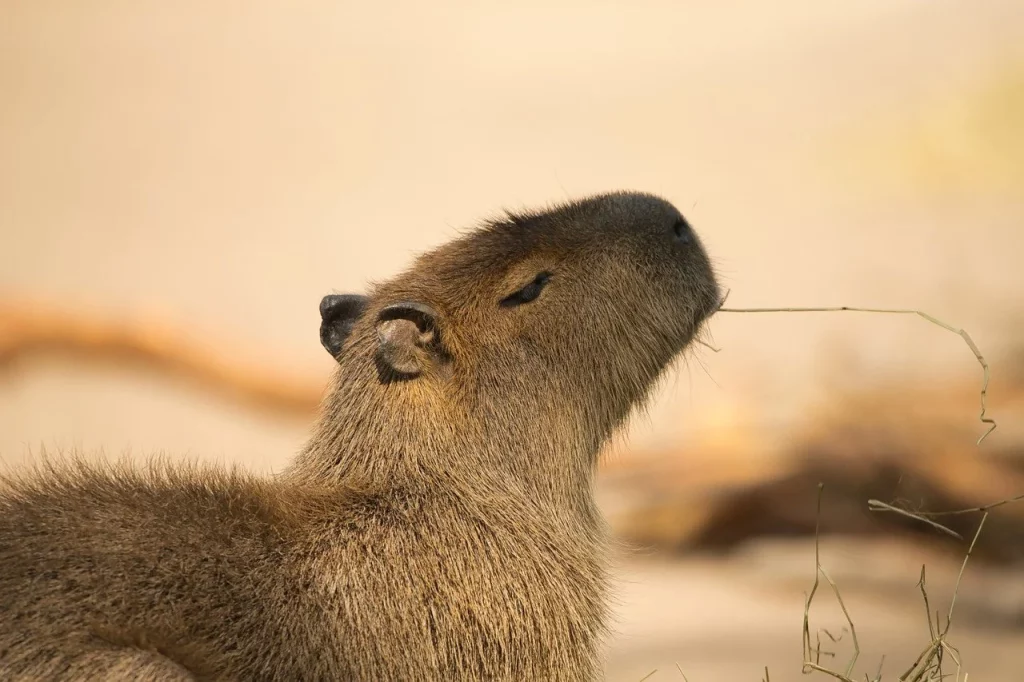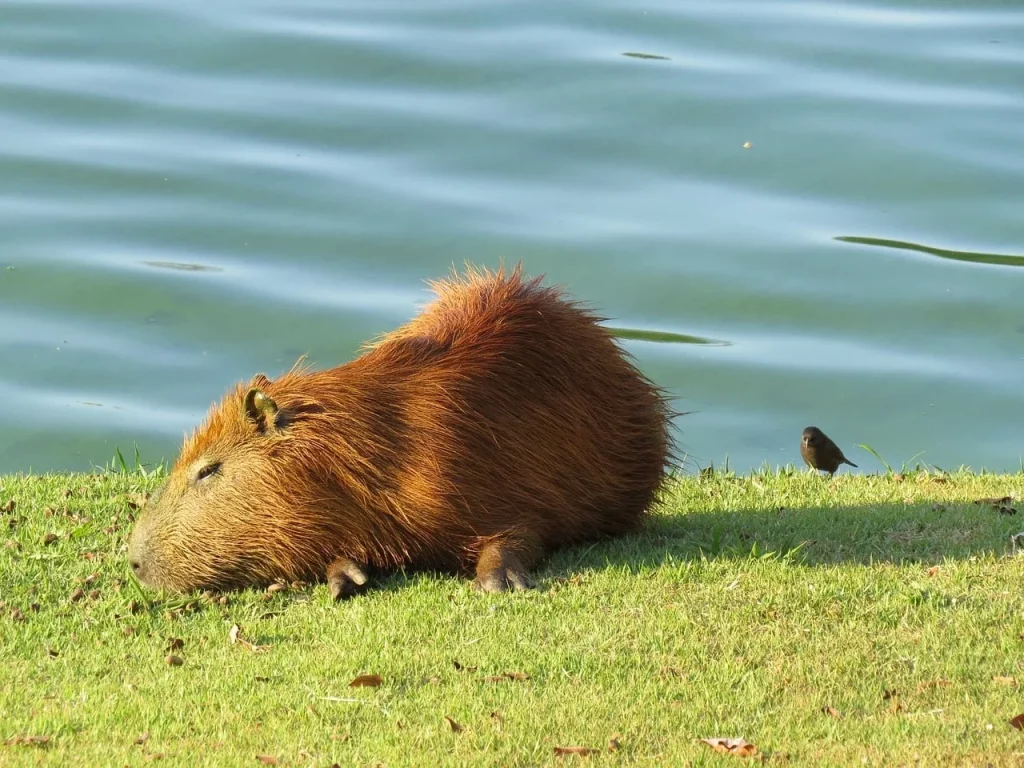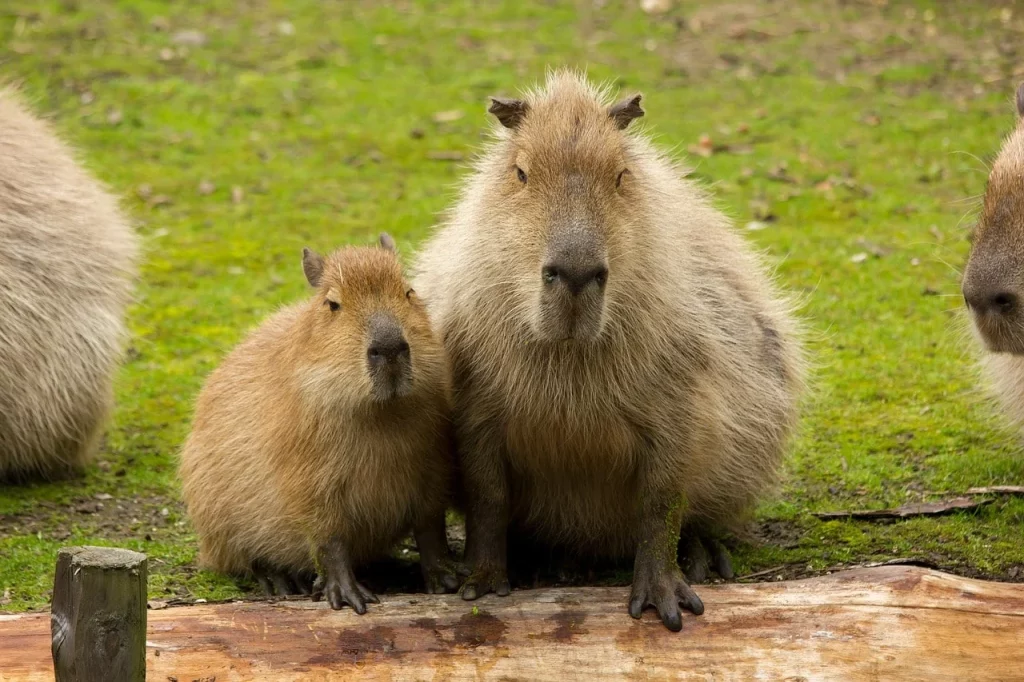Welcome to the enchanting world of capybaras, where the grass is always greener on the other side. These oversized, chill rodents have mastered the art of living the good life, spending their days lounging in muddy waters and snacking on lush vegetation.
But don’t let their laid-back lifestyle fool you; capybaras are fascinating creatures, each with its own quirks and charms. From their social butterfly tendencies to their unexpected swimming skills, there’s a lot more to these gentle giants than meets the eye.
Did you know capybaras are the social influencers of the animal kingdom, always ready for a pool party? So, what’s the most surprising fact you hope to uncover about these adorable creatures? Let’s start our journey.
In the quiet gaze of a capybara, we find the wisdom of nature’s patience.
Dr. Sylvia Earle, Marine Biologist
Capybara Facts
Let’s dive into the beautiful world of capybaras. Keep your eyes open and read these facts carefully, as I created a quiz at the end of the page to test your knowledge about these lovely creatures. Don’t disappoint me.
- The largest rodents on the planet are capybaras, weighing up to 140 pounds.
- Webbed toes aid their prowess in swimming.
- Consuming grass is a critical part of their daily routine, involving hours of feeding.
- In groups of 10 to 20, capybaras exhibit strong social bonds.
- They possess the ability to nap under the water’s surface, with their noses peeking out for air.
- Jaguars, anacondas, and caimans are among their natural adversaries.
- Short bursts of speed allow capybaras to outrun predators on land.
- A special skin gland produces an oily substance to ward off water.
- Sounds like barks, whistles, and grunts facilitate communication within their groups.
- The scientific name for these creatures is Hydrochoerus hydrochaeris.
- Wild capybaras may reach ages of up to 10 years, with the potential for longer life spans under human care.
- Their incisors grow continuously, necessitating constant chewing to manage length.
- Waterborne mating rituals can lead to the birth of up to eight offspring per litter.

- Managing body temperature is assisted by their minimal fur and high body surface area relative to their volume.
- Capybaras have the ability to dive and remain submerged for five minutes, making them adept at underwater escape.
- Eating their own droppings allows them to fully extract nutrients from their food.
- Known as Capivara in Portuguese and Carpincho in Spanish, these animals are integral to South American cultures.
- Social ranking within groups is established, with a dominant male at the forefront.
- Mud baths serve to cool them down and fend off parasites.
- In some cultures, capybaras have been tamed for their meat and fur.
- Scent glands on their faces play a crucial role in territorial demarcation.
- As ecosystem engineers, their presence significantly influences their surroundings and the species that inhabit them.
- Most active during twilight hours, capybaras are crepuscular creatures.
- Insect passengers, such as mosquitoes, frequently feast on capybara blood.
- They exhibit dietary flexibility, consuming both aquatic vegetation and grains.
- Peaceful by nature, they coexist with a variety of other animals, including birds and primates.
- Escape from the heat and predators is often sought in water bodies.
- Thick underbelly fur helps insulate them in cooler waters.

- Collectively, they are known as herds, reflecting their familial groupings.
- Positioning of eyes, ears, and nostrils atop their heads aids in aquatic survival.
- Newborns are remarkably capable, able to move and swim almost immediately after birth.
- Young capybaras engage in playful activities, which are crucial for learning and development.
- Changing environments, particularly habitat destruction, pose significant threats to their numbers.
- Unique among mammals, capybaras can communicate while submerged.
- Annual floods prompt them to seek higher ground, demonstrating their adaptability.
- A complex gut system allows for efficient grass digestion, akin to that of cattle.
- Wattled jacanas and other birds often form mutually beneficial relationships with capybaras, feeding on their parasites.
- Despite their hefty size, they rely on quick water escapes to avoid predation.

- Adapted for slicing through tough vegetation, their dentition is uniquely suited to their diet.
- Conservation efforts deem them of least concern, though certain populations face pressures from hunting and loss of habitat.
- Some areas have regulated the ownership of capybaras as pets due to their specific care requirements.
- Foraging and sentinel behaviors are coordinated within the group for enhanced protection.
- Varying reproductive success is influenced by their living conditions.
- Their paws are uniquely evolved for life both in the water and on land.
- Social grooming and close contact reinforce group cohesion.
- Overheating is a risk due to their limited ability to sweat.
- Studies on capybara behavior enrich our knowledge of animal social systems.
- Generally viewed with affection by the public, they are often described as gentle giants.
- A growing presence in zoological gardens showcases their appeal to global audiences.
- Their potential for urban adaptation has been observed in various South American locales.
Capybara Myths

I hope you enjoyed reading all these interesting facts about capybaras, because we have to move on to the next section. Here, we are going to uncover some popular myths and explore the actual truth behind them.
- Capybaras are Solitary Animals
Capybaras are often thought to be loners, but in reality, they are highly social creatures. They are usually found in groups, sometimes comprising as many as 100 individuals. These groups offer protection against predators and help in finding food, showcasing their sociable nature. - Capybaras Can Be Domesticated Easily
It’s believed by some that they can be domesticated with the same ease as cats or dogs. However, they have complex needs, including a large aquatic habitat, a specific diet, and social interaction with other capybaras, making domestication far from straightforward. - Capybaras Eat Only Plants
While it is true that they are primarily herbivores, their diet is not limited strictly to plants. They have been observed eating small amounts of aquatic animals, such as fish, to obtain essential nutrients, displaying their opportunistic feeding behavior. - Capybaras Are Aggressive
A common misconception exists that capybaras are aggressive. Contrarily, they are known for their docile and friendly nature. Conflicts are rare, and when they occur, they are usually resolved quickly and without violence, emphasizing their peaceful demeanor. - Capybaras Can Live Anywhere
The belief that they can adapt to any environment is widespread. In reality, they are adapted to a semi-aquatic lifestyle in specific climates, requiring access to water bodies for hydration, cooling, and escape from predators. Their habitat preferences are tailored to the wetlands and rivers of South America.
No products found.
Capybara Quotes

Capybaras, being the largest rodents in the world, have a unique charm that sometimes earns them a mention in various contexts. Below, you will find some of my favorite quotes about them:
Capybaras are the Zen masters of the animal kingdom; in their presence, one can’t help but feel at peace.
Thich Nhat Hanh
Thich Nhat Hanh, a revered figure in mindfulness and peace, metaphorically appreciates capybaras for their calm demeanor, suggesting they embody the essence of tranquility and presence.
If diplomacy had a face, it would resemble a capybara’s, for they are the true ambassadors of peaceful coexistence.
Anonymous
This quote by an anonymous person humorously attributes diplomatic qualities to capybaras, admiring their ability to coexist harmoniously with various species.
Watching capybaras interact with their environment is like observing a masterclass in community living.
Jane Goodall
Jane Goodall, famed for her work with primates, draws a comparison between the social structures of capybaras and the intricate societies she has studied, emphasizing their communal and cooperative nature.
Capybaras remind us that sometimes, the best response to life’s chaos is simply to sit, soak, and let the world pass by.
Eckhart Tolle
Eckhart Tolle, known for his teachings on consciousness and the present moment, uses capybaras, often seen lounging in water, as symbols for mindfulness and the power of stillness.
The capybara doesn’t strive to be anything other than itself, and in that, it teaches us the beauty of authenticity.
Brené Brown
Brené Brown, who writes extensively on vulnerability and authenticity, praises capybaras for their unassuming nature, presenting them as exemplars of being true to oneself without pretense.
Capybara FAQ

Before you leap into the quiz, the upcoming FAQ section is essential. Read these questions carefully, because they are going to help you succeed.
- Can Capybaras Swim?
Capybaras are natural swimmers. These charming creatures have webbed feet, which they use to paddle through water. They’re often found in and around bodies of water like rivers, ponds, and marshes in South America. Swimming is essential for their survival, helping them escape predators by diving and staying submerged for up to five minutes. - Are Capybaras Friendly?
They are known for their docile and sociable nature. They are highly social animals that live in groups and can often be seen interacting gently with a variety of other species, including birds, monkeys, and even humans. When kept as pets or in wildlife sanctuaries, they can be very affectionate and even enjoy being petted. - How Many Capybaras Are Left in the World?
Estimating the exact number of capybaras in the wild is challenging due to their widespread distribution across South America. However, their population faces threats from habitat destruction and hunting, which could impact their numbers. Conservation efforts are crucial to ensuring their populations remain stable. - Are Capybaras Endangered?
Capybaras are not classified as endangered. They are listed as a species of “Least Concern” on the IUCN Red List, indicating they are currently widespread and abundant. However, this status does not mean they are free from threats; habitat loss and illegal hunting are ongoing concerns that could affect their future. - How Much Does a Capybara Weigh?
They are the largest rodents in the world, and their weight reflects that title. An adult capybara can weigh anywhere between 35 to 66 kilograms (77 to 146 pounds), with males typically being larger than females. Their hefty size, along with their semi-aquatic lifestyle, helps them navigate both land and water environments efficiently.
No products found.
Capybara Trivia

Welcome to the ultimate capybara quiz, where the stakes are as high as a capybara’s love for water! Fail to answer correctly, and you might just find your bathtub commandeered by a capybara looking for a new swimming spot.
Conclusion
Capybaras, with their sociable spirit, not only captivate our hearts but also remind us of the beauty inherent in nature’s design. They demonstrate the importance of community, relaxation, and the simple joy of lounging in water on a hot day.
These creatures, seemingly mundane at first glance, offer profound lessons on coexistence and the serene pace of life, often overlooked in our fast-paced world. As we bid farewell to our exploration of capybaras, let’s carry with us a slice of their peaceful essence into our daily lives.
And as always, let’s finish this article with a funny question: if capybaras could form a musical band, what do you think they would call it? “The Hairy Tubbies” or “Wet Whiskers Ensemble”? Let me know in the comments.
3 Sources Used For This ArticleAre capybaras friendly to humans – Buy Capybara
Capybaras Facts – Mental Bomb



2 Comments
Capybara no ugly
Don’t forget… Capy e slay